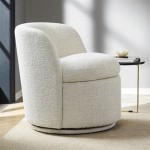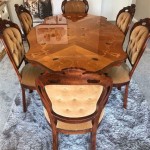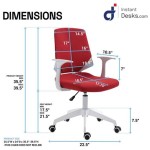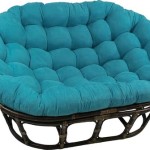Choosing the Perfect Accent Chair for a Beige Sofa
A beige sofa offers a versatile foundation for a living space. Its neutral tone provides a blank canvas upon which various design aesthetics can be implemented through the strategic use of accent pieces. An accent chair, in particular, represents a significant opportunity to introduce color, texture, and personality into the room. Selecting the right accent chair color to complement a beige sofa requires careful consideration of several factors, including the desired mood, the existing color palette, and the overall style of the space. The objective is to create a harmonious and visually appealing environment that reflects individual preferences and enhances the room's functionality.
The inherent neutrality of beige allows for a wide range of color options when choosing an accent chair. From bold and vibrant hues to subtle and sophisticated shades, the possibilities are extensive. However, the key lies in understanding the impact of different colors and their interplay with beige. A poorly chosen accent chair can disrupt the room's balance and create a sense of disharmony, while a well-selected chair can elevate the entire space and add visual interest.
Understanding the Undertones of Beige
Beige, despite its reputation as a neutral color, possesses inherent undertones that influence its interaction with other colors. These undertones can be warm (yellow, orange, or red) or cool (gray, green, or blue). Identifying the undertone of the beige sofa is crucial in determining the most suitable accent chair colors. For instance, a beige sofa with warm undertones will typically pair well with warm accent colors, while a sofa with cool undertones will harmonize better with cool accent colors. Failing to account for these undertones can result in a clash between the sofa and the accent chair, creating a visually jarring effect.
To identify the undertone, it is helpful to compare the beige sofa to other known neutral colors. Place a white object next to the sofa cushion and observe the subtle hues that emerge. Does the beige appear slightly yellowish or pinkish? If so, it is likely a warm beige. Alternatively, does it lean towards gray or green? This indicates a cool beige. Once the undertone is identified, one can proceed with selecting accent chair colors accordingly.
Exploring Complementary and Contrasting Color Schemes
Two primary approaches exist for selecting an accent chair color: complementary and contrasting color schemes. A complementary color scheme involves choosing colors that are opposite each other on the color wheel. For example, blue and orange are complementary colors. In the context of a beige sofa, a complementary color scheme might involve selecting an accent chair in a shade of blue. The blue chair will create a striking contrast against the beige sofa, adding visual interest and depth to the room. However, it is important to consider the specific shades of blue and beige involved. A bright, saturated blue might be overwhelming against a light beige, while a muted, dusty blue could create a more subtle and sophisticated effect.
A contrasting color scheme, on the other hand, involves selecting colors that are significantly different from beige but not necessarily opposite each other on the color wheel. For example, a deep emerald green or a rich burgundy could serve as effective contrasting colors against a beige sofa. These colors will create a sense of drama and sophistication in the room. However, it is crucial to ensure that the contrasting color complements the overall style of the space and does not overwhelm the neutral beige. Using accent pillows and throws in coordinating colors can help to tie the contrasting elements together and create a cohesive look.
Considering Different Color Options
Several specific color options consistently prove successful when paired with a beige sofa. These colors offer varying degrees of contrast and visual impact, allowing for customization based on individual preferences and the desired aesthetic.
Blue: As mentioned earlier, blue is a versatile option that works well with both warm and cool beiges. Lighter shades of blue, such as powder blue or sky blue, can create a calming and airy atmosphere, while darker shades, such as navy blue or indigo, can add depth and sophistication. A blue velvet accent chair can introduce a luxurious texture, further enhancing the visual appeal of the room.
Green: Green is another excellent choice, particularly for beige sofas with warm undertones. Earthy greens, such as olive green or sage green, can create a natural and organic feel, while brighter greens, such as emerald green or lime green, can add a pop of color and energy. A green linen accent chair can provide a comfortable and inviting seating option.
Gray: Gray is a sophisticated and timeless option that works particularly well with cool beiges. Different shades of gray, from light silver to dark charcoal, can create a range of moods, from minimalist and modern to cozy and inviting. A gray leather accent chair can add a touch of elegance and masculinity to the room.
Yellow: Yellow is a cheerful and optimistic color that can brighten up any space. It works particularly well with beige sofas that need a touch of warmth. Mustard yellow or golden yellow can create a vintage-inspired look, while brighter yellows, such as lemon yellow or canary yellow, can add a playful and energetic vibe. A yellow patterned accent chair can introduce visual interest and personality.
Pink: Pink can be a surprisingly versatile option, particularly when paired with a beige sofa. Dusty rose or blush pink can create a soft and romantic atmosphere, while bolder shades of pink, such as fuchsia or magenta, can add a touch of drama and glamour. A pink velvet accent chair can introduce a luxurious and feminine touch.
Orange: Orange adds a vibrant and energetic pop of color, working well as a contrast to the neutral beige. Terracotta or burnt orange can evoke a warm, earthy feel, while brighter oranges create a more playful aesthetic. Consider the shade of orange against the undertones of the beige to ensure a pleasant visual balance.
Considering the Texture and Pattern of the Accent Chair
In addition to color, the texture and pattern of the accent chair play a crucial role in complementing a beige sofa. A textured fabric, such as velvet, linen, or boucle, can add depth and visual interest to the room, while a patterned fabric can introduce personality and character. When choosing a textured or patterned accent chair, it is important to consider the overall style of the space and the existing furniture pieces. A heavily textured or patterned chair might be overwhelming in a minimalist space, while a plain chair might lack visual interest in a more eclectic setting.
For instance, a velvet accent chair can add a touch of luxury and sophistication to a room with a beige sofa. The soft, plush texture of velvet creates a sense of comfort and warmth, while the sheen of the fabric adds a touch of glamour. A linen accent chair, on the other hand, can create a more relaxed and casual atmosphere. The natural texture of linen adds a touch of rustic charm, while the breathable fabric makes it a comfortable seating option. A patterned accent chair can introduce visual interest and personality to a room with a beige sofa. A floral pattern can create a romantic and feminine feel, while a geometric pattern can create a modern and contemporary look. The key is to choose a pattern that complements the overall style of the space and does not clash with the other furniture pieces.
The Importance of Visual Balance and Cohesion
Ultimately, the goal of selecting an accent chair for a beige sofa is to create a visually balanced and cohesive space. This involves considering all the elements of the room, including the color, texture, pattern, and scale of the furniture pieces. The accent chair should complement the beige sofa and other furnishings, creating a sense of harmony and unity. It should not stand out as a sore thumb or disrupt the overall flow of the room.
To achieve visual balance, it is helpful to consider the placement of the accent chair in relation to the beige sofa. An accent chair placed directly next to the sofa will create a sense of symmetry and formality, while an accent chair placed at an angle to the sofa will create a more relaxed and informal atmosphere. The size and scale of the accent chair should also be proportional to the size of the sofa and the overall dimensions of the room. A large, oversized accent chair can overwhelm a small space, while a small, dainty accent chair can get lost in a larger room.
In addition to the accent chair itself, the surrounding accessories can also contribute to visual balance and cohesion. Throw pillows, blankets, rugs, and artwork can all be used to tie the accent chair and beige sofa together. Choosing accessories in coordinating colors and patterns can help to create a cohesive look and enhance the overall appeal of the room.

The Ultimate Guide To Buying An Accent Chair Everything You Need Know Grain Frame

The Ultimate Guide To Buying An Accent Chair Everything You Need Know Grain Frame

The Ultimate Guide To Buying An Accent Chair Everything You Need Know Grain Frame

The Ultimate Guide To Buying An Accent Chair Everything You Need Know Grain Frame

25 Beige Accent Chairs To Enhance Your Seating Space

15 Beige Sofa Living Room Ideas For A Modest And Serene Look Coco Lapine Designcoco Design

15 Beige Sofa Living Room Ideas For A Modest And Serene Look Coco Lapine Designcoco Design

What Color Accent Chairs Go With A White Couch Duhome Furniture

15 Beige Sofa Living Room Ideas For A Modest And Serene Look Coco Lapine Designcoco Design

15 Beige Sofa Living Room Ideas For A Modest And Serene Look Coco Lapine Designcoco Design







